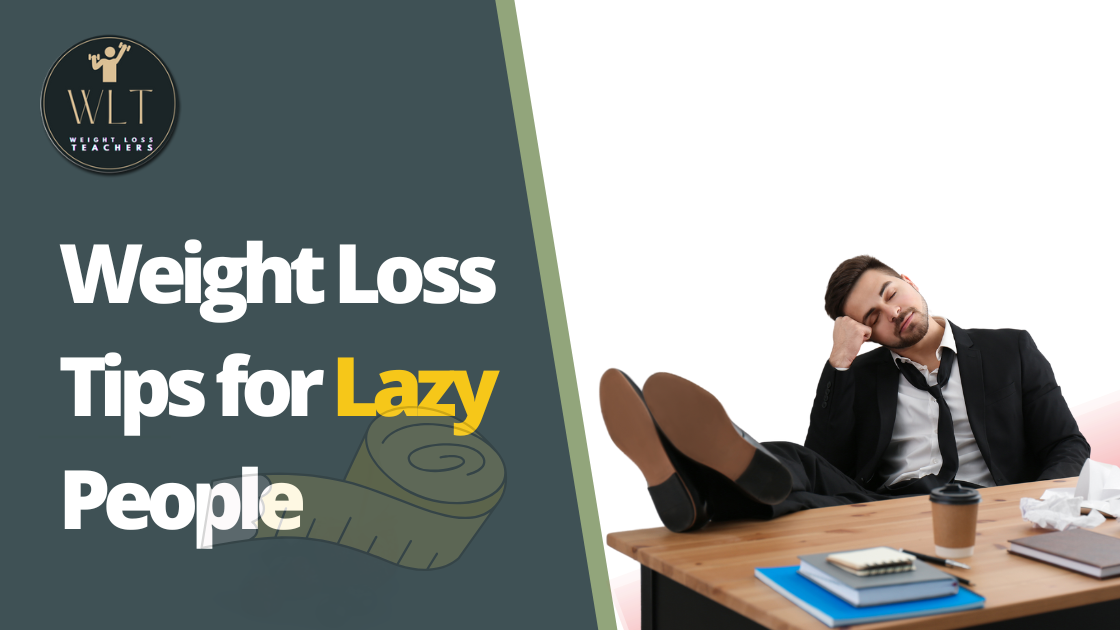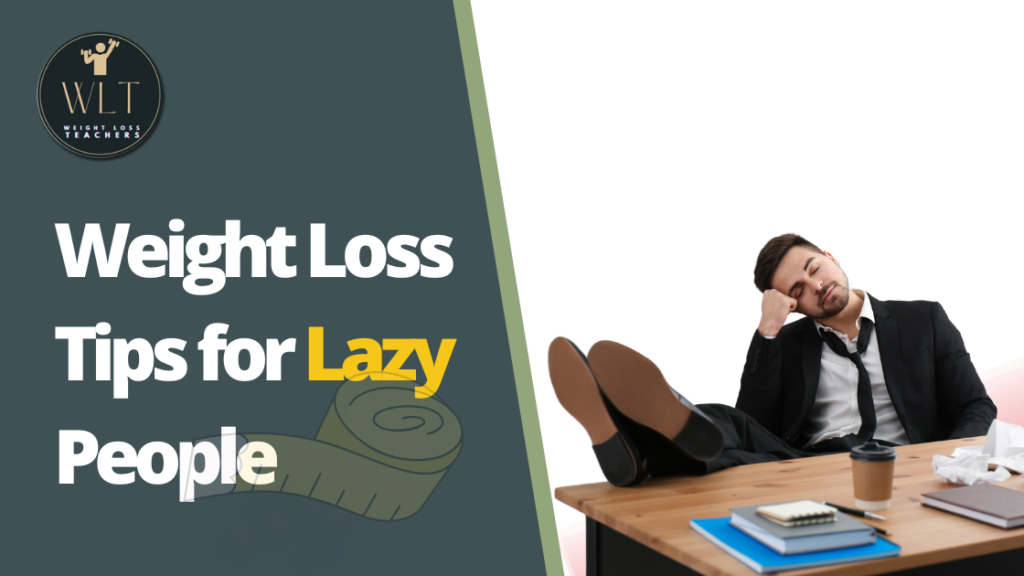
Weight Loss Tips for Lazy People

In a world that constantly glorifies productivity, being labeled as “lazy” can be seen as a negative trait. However, when it comes to weight loss, being a little lazy can actually work to your advantage.
Table of Contents
Introduction
In a world that constantly glorifies productivity, being labeled as “lazy” can be seen as a negative trait. However, when it comes to weight loss, being a little lazy can actually work to your advantage.

Understanding Your Laziness

Before embarking on your weight loss journey, it’s essential to take a moment to truly understand your own brand of laziness. Contrary to popular belief, being labeled as “lazy” does not equate to a lack of motivation or ambition. In fact, it often stems from a desire to conserve energy for more enjoyable and meaningful activities. This distinction is vital when tailoring a weight loss strategy that harmonizes with your natural tendencies.
Lazy individuals often find conventional weight loss methods daunting or unsustainable. The idea of becoming a fitness fanatic or adhering to a strict diet can feel overwhelming and unattainable. However, understanding your inclination to conserve energy can be the first step toward achieving your weight loss goals.
Recognizing that your laziness is a preference rather than a flaw is empowering. It allows you to approach weight loss in a way that feels authentic and sustainable for you. Instead of forcing yourself into a mold that doesn’t fit, you can tailor your journey to align with your natural tendencies.
For example, if you prefer conserving energy, you can opt for lower-intensity exercises like leisurely walks, gentle yoga, or casual swimming. These activities can help you burn calories without pushing yourself too hard or feeling like you’re exhausting precious energy reserves. Similarly, you can choose to make gradual dietary changes that don’t disrupt your daily routine, such as swapping sugary beverages for water or incorporating more fruits and vegetables into your meals.
Setting Realistic Weight Loss Goals

When embarking on a weight loss journey, setting realistic goals is paramount to your success, particularly for those who identify as having a “lazy streak.” The importance of this step cannot be overstated. Unrealistic expectations, such as aiming to lose an excessive amount of weight in a short period, can lead to disappointment, demotivation, and ultimately, failure. To make your weight loss journey manageable and sustainable, follow these guidelines for goal-setting.
- Specific Goals: Start by defining clear and specific objectives. Instead of a vague goal like “losing weight,” specify the amount you want to lose, such as “losing 10 pounds.” This clarity provides a concrete target to work toward.
- Measurable Goals: Make sure your goals are measurable so that you can track your progress. For instance, if your goal is to increase physical activity, you could aim to walk 10,000 steps a day or spend 30 minutes exercising three times a week. Measurable goals allow you to assess your achievements accurately.
- Attainable Goals: Avoid setting yourself up for failure by establishing attainable goals. Unrealistic objectives, such as losing an extreme amount of weight rapidly, are often unattainable and can lead to frustration. Instead, focus on gradual, sustainable progress that aligns with your capabilities and lifestyle.
- Realistic Timeframes: Be mindful of your timeline. Rapid weight loss can be unhealthy and challenging to maintain. Instead of aiming for quick results, set a realistic timeframe for your goals. For instance, aim to lose 1-2 pounds per week, which is considered a safe and achievable rate.
- Adjustable Goals: Understand that your weight loss journey may encounter obstacles and setbacks. It’s essential to be flexible and willing to adjust your goals as needed. Life can be unpredictable, and adapting your objectives allows you to stay on track even when faced with challenges.
By following these goal-setting principles, you can ensure that your weight loss journey remains realistic, motivating, and sustainable. Setting specific, measurable, attainable, realistic, and adjustable (SMART) goals is a proven strategy that can help you make steady progress without overwhelming yourself.
Prioritizing Sleep for Effective Weight Loss

For those with a “lazy streak,” prioritizing sleep might just be the easiest and most enjoyable step toward achieving your weight loss goals. Contrary to common misconceptions, sleep is a crucial factor in weight management and aligns seamlessly with a relaxed lifestyle. Here’s why making quality sleep a priority is essential for your weight loss journey:
- Recovery and Restoration: During sleep, your body undergoes vital processes of recovery and restoration. It repairs and rebuilds tissues, strengthens the immune system, and replenishes energy levels. Adequate sleep ensures your body is functioning optimally, facilitating weight loss efforts.
- Hormonal Regulation: Sleep plays a crucial role in regulating hormones related to hunger and appetite, such as leptin and ghrelin. When you don’t get enough sleep, these hormones become imbalanced, leading to increased feelings of hunger and a higher likelihood of overeating, especially of calorie-dense, unhealthy foods.
- Stress Reduction: Lazy individuals may also be prone to stress-related eating. A lack of sleep can elevate stress levels, making it more challenging to resist comfort foods. Prioritizing sleep can help lower stress levels, reducing the desire to indulge in unhealthy snacks.
To make sleep a priority for effective weight loss, aim for 7-9 hours of quality sleep per night. Establishing a regular sleep schedule, creating a comfortable sleep environment, and practicing relaxation techniques before bed can contribute to better sleep quality. By prioritizing sleep, you’re not only enhancing your weight loss efforts but also boosting your overall well-being, making it a perfect fit for a “lazy” lifestyle.
Embracing Mindful Eating for Lazy Weight Loss

For individuals who identify as “lazy,” the prospect of restrictive diets or complicated meal plans can be daunting. However, there is a simple and effective approach to weight loss that perfectly aligns with a laid-back lifestyle – mindful eating. Mindful eating involves a profound connection with your food, paying close attention to every aspect of your meal, and practicing awareness during the eating process. This approach can significantly contribute to weight loss without the need for strenuous willpower or drastic changes in your routine.
- Engage Your Senses: Mindful eating begins by engaging all your senses. Take a moment to appreciate the colors, textures, and aromas of your food. This sensory awareness not only enhances the eating experience but also helps you become more connected to what you’re consuming.
- Savor Each Bite: Lazy individuals can benefit from slowing down their eating pace. Instead of rushing through a meal, savor each bite. Chew your food thoroughly and enjoy the flavors. This not only enhances your appreciation for the meal but also allows your body to register fullness more effectively.
- Recognize Hunger and Fullness: Mindful eating encourages you to listen to your body’s hunger and fullness cues. Before eating, ask yourself if you’re truly hungry or eating out of habit or boredom. During the meal, pay attention to your body’s signals, and stop eating when you feel comfortably satisfied rather than overly full.
- Eliminate Distractions: Lazy individuals may have a tendency to eat in front of the TV or computer, distracted by other activities. Mindful eating encourages you to eliminate distractions and focus solely on your meal. By doing so, you’re more likely to enjoy your food and recognize when you’ve had enough.
- Reduce Emotional Eating: Emotional eating is a common challenge, particularly for those who prefer a more relaxed lifestyle. Mindful eating helps you become more attuned to your emotions and how they impact your eating habits. Instead of turning to food for comfort, you can find alternative ways to address emotional needs.
Incorporating mindful eating into your daily routine can have a profound impact on your weight loss journey. It doesn’t require significant effort or drastic changes to your lifestyle, making it an ideal approach for those who prefer a more relaxed way of life. By becoming more aware of your food choices and eating habits, you can naturally reduce overeating, make healthier choices, and achieve your weight loss goals in a sustainable and enjoyable manner.
Small Dietary Changes for Lazy Weight Loss Success

Weight loss doesn’t always necessitate radical dietary shifts or extreme restrictions. Lazy individuals can achieve significant results by making small, sustainable changes to their eating habits. These gradual modifications can lead to steady weight loss over time without the need for dramatic lifestyle overhauls. Here are some practical steps for incorporating small dietary changes into your daily routine:
- Hydration Habits: Swap sugary drinks for healthier alternatives like water, herbal tea, or infused water. Staying hydrated is essential for overall health and can help control your appetite.
- Whole Grains vs. Refined Grains: Opt for whole grains instead of refined grains. Whole grain options, such as brown rice, quinoa, and whole wheat bread, are higher in fiber and nutrients, making you feel fuller for longer.
- Incorporate More Fruits and Vegetables: Lazy individuals can gradually increase their fruit and vegetable intake. Try adding a serving of fruits or vegetables to each meal, whether it’s a handful of berries with breakfast or a side salad with dinner.
- Mindful Snacking: Pay attention to your snacking habits. Instead of mindlessly reaching for unhealthy snacks, keep nutritious options like nuts, yogurt, or cut-up veggies readily available for when hunger strikes between meals.
- Portion Control: Lazy individuals can practice portion control without feeling deprived. Use smaller plates, bowls, and utensils to naturally reduce portion sizes while still enjoying your favorite foods.
- Cook at Home: Cooking at home allows you to have more control over your meals. Lazy individuals can start with simple, quick recipes and gradually expand their cooking repertoire.
- Plan Balanced Meals: Plan balanced meals that include a variety of food groups. Aim to include lean protein, whole grains, and plenty of fruits and vegetables in your daily menu.
These small dietary changes may seem insignificant individually, but when combined and practiced consistently, they can have a substantial impact on your weight loss journey. Lazy individuals can take comfort in knowing that these modifications are manageable and sustainable, fitting seamlessly into their preferred lifestyle. Over time, you’ll likely notice positive changes in your body and overall well-being without feeling like you’ve undergone a drastic transformation in your eating habits.
The Power of Slow Eating for Weight Loss

For individuals with a penchant for laziness, the idea of slowing down during meals might seem counterintuitive. After all, why spend more time eating when you could be relaxing or doing something more enjoyable? However, embracing the practice of slow eating can be a lazy person’s secret weapon for achieving weight loss goals.
- Preventing Overeating: One of the primary benefits of eating slowly is that it prevents overeating. When you consume your meals too quickly, your body doesn’t have adequate time to signal that it’s full. This delay in communication between your stomach and brain can lead to consuming more calories than necessary. By slowing down, you give your body the opportunity to recognize satiety, helping you naturally reduce your calorie intake.
- Enhancing Enjoyment: Lazy individuals can find great pleasure in the act of savoring their food. Slowing down allows you to fully appreciate the flavors, textures, and aromas of your meals. This heightened sensory experience can make even the most ordinary dishes feel indulgent, leading to greater satisfaction with smaller portions.
- Mindful Eating: Slow eating naturally encourages mindfulness during meals. It prompts you to be more aware of what you’re eating, promoting a deeper connection with your food. This mindfulness extends to recognizing hunger cues and eating in response to genuine physical hunger rather than emotional or external triggers.
- Reduced Need for Willpower: For many, weight loss efforts involve significant willpower to resist overindulging in tempting foods. Slowing down your eating pace reduces the need for strenuous willpower. Instead of relying on self-control to stop eating, you naturally stop when you feel satisfied, making the process less mentally taxing.
To incorporate slow eating into your routine, start by setting aside dedicated time for meals. Eliminate distractions, such as TV or smartphones, and focus solely on your food. Take small bites, chew slowly, and put your utensils down between bites. Engage in conversation with dining companions, allowing for breaks between mouthfuls. By making these gradual adjustments to your eating habits, you can harness the power of slow eating as an effective weight loss strategy that aligns with your laid-back lifestyle.
The Weight Loss Benefits of Proper Hydration

Proper hydration is an essential component of overall health, and for individuals with a propensity for laziness, it can be a straightforward yet highly effective strategy for weight loss. Lazy individuals often seek practical and low-effort solutions, making hydration an ideal tool in their weight loss journey.
- Appetite Control: Drinking water before meals can be a lazy person’s secret weapon against overeating. Water takes up space in your stomach, and consuming it before a meal can create a sense of fullness, reducing the likelihood of overindulging in calorie-dense foods. This simple practice curbs your appetite without requiring significant effort.
- Calorie Reduction: Staying hydrated can inadvertently reduce calorie consumption. Lazy individuals who replace sugary drinks or high-calorie beverages with water or herbal tea automatically decrease their daily calorie intake. It’s a subtle way to trim calories without the need for stringent dietary restrictions.
- Improved Metabolism: Proper hydration is essential for maintaining a healthy metabolism. When your body is adequately hydrated, it can efficiently process and burn calories. Dehydration, on the other hand, can slow down your metabolism, making weight loss more challenging.
To incorporate hydration into your weight loss strategy, keep a water bottle within easy reach throughout the day. Sip water regularly, not just when you feel thirsty, as thirst is often a sign of dehydration. Herbal teas and infused water can add variety to your hydration routine and make it more enjoyable. By staying hydrated, you’re not only supporting your overall health but also creating an effortless and effective tool for weight management, aligning perfectly with a lazy person’s lifestyle.
Effortless Fitness: Low-Effort Exercises for Lazy Weight Loss

For those with a proclivity for laziness, the thought of intense gym sessions or grueling workouts can be a significant deterrent when it comes to weight loss. Fortunately, weight loss doesn’t have to entail strenuous exercise routines. Lazy individuals can opt for low-effort exercises that are effective in burning calories and shedding pounds without feeling like an unbearable chore. The key is to find an activity you genuinely enjoy, making it easier to incorporate into your daily routine.
- Walking: Walking is one of the most accessible and effective low-effort exercises for weight loss. It doesn’t require any special equipment or training, making it ideal for lazy individuals. Start with short walks and gradually increase your duration and pace. A leisurely stroll through your neighborhood or a scenic park can burn calories while providing relaxation and fresh air.
- Swimming: Swimming is a low-impact exercise that is gentle on the joints, making it suitable for lazy individuals who might shy away from high-impact workouts. It engages multiple muscle groups, promoting calorie burning and toning. Whether you’re doing laps in a pool or floating leisurely, swimming can be an enjoyable way to lose weight.
- Cycling: Riding a bicycle at a leisurely pace is another excellent low-effort exercise option. You can explore your surroundings while burning calories without the intensity of a strenuous bike ride. Consider biking to nearby destinations or simply pedaling around your neighborhood for relaxation and weight loss benefits.
- Yoga: Yoga is a versatile exercise option that ranges from gentle and restorative to more challenging practices. Lazy individuals can start with beginner-level yoga sessions that focus on flexibility, balance, and relaxation. Yoga not only aids in weight loss but also promotes mental well-being.
- Dancing: Dancing is a fun and effective way to burn calories without feeling like you’re exercising. Whether you enjoy dancing at home to your favorite music or taking low-intensity dance classes, it’s a great way to stay active while having a good time.
- Gardening: For those who prefer a more laid-back approach, gardening can be an excellent way to incorporate movement into your daily routine. Planting, weeding, and tending to your garden can provide a low-effort workout while nurturing your green space.
By selecting low-effort exercises that align with your preferences, you can make physical activity a more enjoyable and sustainable part of your daily life. Remember that consistency is key; even small amounts of regular exercise can lead to significant weight loss over time. Plus, the relaxed nature of these activities ensures that you won’t feel overwhelmed or drained, making them perfect for those who prefer a more laid-back lifestyle.
Effortless Weight Loss: Incorporating Movement into a Lazy Lifestyle

Lazy individuals often struggle with the idea of dedicating time to structured exercise routines or hitting the gym regularly. However, weight loss doesn’t always require intensive workouts. For those who prefer a more relaxed way of life, incorporating movement into your daily routine can be a practical and effective approach to shedding pounds. By seeking opportunities to move without making it a separate task, you can gradually and effortlessly work toward your weight loss goals.
- Opt for Stairs: A simple yet effective way to incorporate movement into your routine is to opt for stairs over elevators or escalators. Whether you’re at work, in a shopping mall, or in your apartment building, taking the stairs is an easy way to burn extra calories while going about your day.
- Park Farther Away: When driving to a destination, choose to park farther away from your target location. This small adjustment increases the distance you need to walk, adding extra steps to your day without any additional effort.
- Active Commuting: If feasible, consider walking or biking to work instead of driving or taking public transportation. This not only contributes to weight loss but also reduces your carbon footprint and supports the environment.
- Household Chores: Lazy individuals can turn household chores into a form of exercise. Vacuuming, sweeping, gardening, and other chores can burn calories while maintaining a tidy living space.
- Active Hobbies: Pursue hobbies that involve movement. Whether it’s dancing, hiking, playing recreational sports, or taking leisurely bike rides, these activities can contribute to weight loss while providing enjoyment.
- Walking Pets: If you have pets, use their walks as an opportunity to get some exercise. Enjoy leisurely strolls with your dog or play with them at a nearby park.
By integrating movement into your daily routine, you can make weight loss a natural and effortless part of your lifestyle. These small adjustments may not feel like traditional exercise, but they add up over time and contribute to calorie expenditure, helping you achieve your weight loss goals without drastically altering your laid-back way of life.
Note: There might be affiliate links mentioned here. We may receive a commission if you purchase a product through an affiliate link. There is no additional charge for you. Please do your own research before making any online purchases.
Creating the Perfect At-Home Workout Space

For individuals who prefer the comfort and convenience of home, establishing a comfortable workout space can be a game-changer in their weight loss journey. This approach eliminates the need to commute to a gym, removes potential barriers to exercise, and can make working out more accessible and appealing. Here’s how to set up an inviting at-home workout environment.
- Designate a Space: Choose a dedicated corner or area in your home that can serve as your workout zone. This space should be free from clutter and distractions, allowing you to focus on your fitness routine. It doesn’t need to be large – even a small area can suffice.
- Invest in Basic Equipment: You don’t need an extensive home gym to get started. Consider purchasing a few essential pieces of equipment, such as a yoga mat, resistance bands, dumbbells, or kettlebells, depending on your fitness preferences. These versatile tools can provide a wide range of workout options.
- Set a Routine: Establish a regular workout schedule that suits your lifestyle. Consistency is key to achieving your weight loss goals. Whether it’s early morning, during lunch breaks, or in the evening, having a set time for exercise ensures you prioritize it.
- Variety is Key: To prevent monotony, incorporate variety into your workouts. Rotate between different types of exercises and fitness routines to keep things interesting and challenging.
By setting up a comfortable and appealing workout space at home, you remove common barriers to exercise and make it easier to stay on track with your weight loss goals. The convenience and accessibility of your personal fitness haven can be a powerful motivator, especially for those who prefer a more laid-back approach to physical activity.
Mastering Portion Control for Lazy Weight Loss

Portion control is a simple yet highly effective strategy for managing calorie intake and achieving weight loss, making it a valuable tool for lazy individuals looking to shed pounds without making significant lifestyle changes. This approach allows you to continue enjoying your favorite foods while being mindful of portion sizes. Here’s how to practice portion control effectively:
- Smaller Plates and Bowls: One of the easiest ways to control portion sizes is to use smaller plates and bowls. When you serve meals on smaller dishware, it visually appears as a more substantial portion, tricking your brain into feeling satisfied with less food.
- Mindful Serving: Before you start eating, take a moment to assess the portion size on your plate. Ask yourself if it’s appropriate for your dietary goals. Be mindful of portion sizes when dishing out your meals, and avoid the temptation to pile on excessive servings.
- Plate Half Vegetables: Fill at least half of your plate with vegetables or salad. Vegetables are low in calories and high in fiber, which can help you feel full and satisfied without consuming excess calories.
- Avoid Second Helpings: Resist the urge to go back for seconds. If you’re still hungry after your initial portion, wait for a few minutes to allow your body to register fullness. You may find that you don’t need additional food.
- Divide Snacks: If you enjoy snacks like chips, nuts, or trail mix, portion them out into small containers or bags rather than eating from the main package. This ensures that you’re aware of how much you’re consuming.
- Share Desserts: When dining out or indulging in dessert, consider sharing with a friend or family member. This not only reduces calorie intake but also allows you to enjoy a treat without overindulging.
- Slow Down: Eating slowly and savoring each bite gives your body time to register fullness. Enjoy the flavors and textures of your food, and put your fork or spoon down between bites.
Portion control doesn’t require complex calculations or strict dietary restrictions. It’s a flexible approach that can fit seamlessly into your daily life. By being mindful of your portions, you can maintain a balanced diet, prevent overeating, and create a sustainable path toward weight loss – all with minimal effort, making it an ideal strategy for those who prefer a more laid-back approach to health and fitness.
Stock Up on Healthy Snacks

Snacking can be a significant stumbling block for individuals on a weight loss journey, particularly for those with a propensity for laziness. The allure of convenience store chips or sugary treats can be strong when hunger strikes, but there’s a smarter way to satisfy your cravings without sabotaging your goals. Lazy individuals can take a proactive approach by stocking up on healthy snacks that are readily available and equally delicious. Here’s how to build a stash of nutritious snacks that will support your weight loss efforts:
- Fresh Fruits: Fresh fruits are nature’s perfect snacks. They’re packed with vitamins, minerals, and fiber, which provide essential nutrients while helping you stay full. Keep a variety of fruits like apples, bananas, and berries on hand for a quick, guilt-free nibble.
- Greek Yogurt: Greek yogurt is a protein-packed snack that can keep you feeling satisfied. Opt for plain, non-fat Greek yogurt and add your own flavor with honey, fresh fruit, or a sprinkle of nuts.
- Nuts and Seeds: Nuts and seeds are nutrient-dense snacks that provide healthy fats and protein. Almonds, walnuts, and chia seeds are excellent choices. However, be mindful of portion sizes as they are calorie-dense.
- Dried Fruit: While dried fruit should be consumed in moderation due to its higher sugar content, it can be a sweet and satisfying snack when paired with a small portion of nuts.
- Dark Chocolate: For those with a sweet tooth, dark chocolate with a high cocoa content (70% or more) can satisfy cravings with less sugar than milk chocolate.
To make smart snacking even more effortless, portion out your snacks into small containers or baggies in advance. Having these pre-portioned snacks readily available in your pantry or fridge can make it easier to resist the temptation of unhealthy options when laziness strikes. By choosing wholesome and nutritious snacks, you can satisfy your cravings and stay on track with your weight loss goals without the need for drastic dietary changes.
Limit Processed Foods

Processed foods have become a staple in many diets due to their convenience and extended shelf life. However, for individuals aiming to shed excess weight, especially those who prefer a more relaxed approach to lifestyle changes, limiting processed foods can be a crucial step toward achieving their weight loss goals. Here’s why and how to gradually reduce the consumption of processed foods in favor of whole, unprocessed options:
- Nutrient Density: Processed foods often lack the essential nutrients found in whole foods. These nutrient-poor choices can leave you feeling unsatisfied and more prone to overeating. Whole foods, on the other hand, are packed with vitamins, minerals, and fiber that promote satiety and support overall health.
- Caloric Awareness: Processed foods tend to be calorie-dense while lacking the satiety that whole foods provide. This can lead to unintentional overconsumption of calories, hindering weight loss progress. Whole foods, such as fruits, vegetables, and lean proteins, offer lower calorie density with greater satiety.
- Less Sugar and Salt: Processed foods often contain added sugars and excessive salt to enhance flavor. These additives can contribute to weight gain and other health issues. Whole foods allow you to control your sugar and salt intake more effectively.
- Sustainable Weight Loss: Gradually replacing processed foods with whole foods can lead to sustainable weight loss. This approach doesn’t require drastic changes in your eating habits, making it more accessible for those who prefer a laid-back lifestyle.
By gradually reducing your reliance on processed foods and incorporating more whole, unprocessed options into your diet, you can support your weight loss efforts while maintaining a laid-back approach to lifestyle changes. This approach allows you to enjoy nutritious and satisfying meals without the need for extreme dietary restrictions, making it a sustainable path to your desired weight.
Manage Stress

Stress is a common and often unavoidable aspect of modern life, and its impact on weight gain and emotional eating can be particularly challenging for individuals who lean towards a lazier disposition. However, effectively managing stress is not only crucial for your mental well-being but also plays a significant role in maintaining a healthy weight. For those looking to shed pounds without exerting too much effort, implementing stress management techniques is essential. Here’s how to incorporate relaxation practices into your routine to reduce stress levels and improve overall well-being:
- Deep Breathing: Deep breathing exercises are a quick and accessible way to combat stress. Whenever you feel overwhelmed or stressed, take a few minutes to focus on your breath. Inhale deeply through your nose, allowing your abdomen to rise, and then exhale slowly through your mouth. This simple practice can help calm your nervous system and reduce stress levels.
- Meditation: Meditation is a powerful tool for stress reduction and mindfulness. You don’t need to dedicate hours to meditation; even a short daily practice can make a difference. Use guided meditation apps or videos to get started and gradually build your meditation routine.
- Yoga: Yoga combines physical movement with mindfulness, making it an excellent choice for stress management. There are various yoga styles, so you can choose one that suits your fitness level and preferences. Practicing yoga regularly can help improve flexibility, reduce stress, and support weight loss.
- Nature Walks: Lazy individuals can benefit from leisurely walks in natural settings. Nature walks provide an opportunity to unwind, disconnect from daily stressors, and enjoy the calming effects of being outdoors. Aim for short, relaxed walks in parks or scenic areas.
- Social Connections: Maintain social connections with friends and loved ones. Sharing your feelings and experiences with trusted individuals can provide emotional support and alleviate stress.
- Professional Help: If stress becomes overwhelming or chronic, consider seeking help from a mental health professional. Therapy or counseling can provide valuable tools and strategies for managing stress effectively.
It’s essential to remember that managing stress is not a one-size-fits-all approach. Experiment with different stress-relief techniques to discover what works best for you. Consistency is key, so integrate stress management practices into your daily routine to experience their full benefits. By reducing stress, you can not only support your weight loss efforts but also enhance your overall quality of life.
Seek Professional Guidance

Weight loss journeys can be daunting, especially for those with a more laid-back approach to lifestyle changes. If you find yourself struggling to achieve your weight loss goals on your own, seeking professional guidance can be a game-changer. Registered dietitians and certified personal trainers are experts in their fields, equipped to provide personalized advice and support tailored to your unique needs and preferences. Here’s why enlisting professional help can make a significant difference in your lazy weight loss journey:
- Customized Plans: Professionals like registered dietitians can create customized nutrition plans that align with your lazy tendencies. They consider your lifestyle, food preferences, and goals to design a sustainable eating strategy that you can comfortably integrate into your daily routine. This tailored approach makes it easier to maintain healthy habits over time.
- Expertise: Professionals bring a wealth of knowledge and expertise to the table. They stay up-to-date with the latest research in nutrition and exercise science, ensuring that their guidance is based on evidence-based practices rather than fads or trends.
- Accountability: Having a professional to check in with can provide an extra layer of accountability. Knowing that you have appointments or consultations scheduled can motivate you to stay on track with your weight loss efforts.
- Problem-Solving: Weight loss can come with challenges, and professionals are skilled at troubleshooting obstacles that may arise along the way. Whether it’s breaking through a weight loss plateau or addressing emotional eating, they can provide strategies to overcome these hurdles.
- Motivation: Professionals can serve as a source of motivation and encouragement. They celebrate your successes, no matter how small, and provide constructive feedback to keep you moving toward your goals.
When seeking professional guidance, it’s essential to find a provider who aligns with your goals and values. Research their qualifications, read reviews, and consider scheduling an initial consultation to discuss your needs and assess your compatibility.
FAQs (Frequently Asked Questions)
Q1. How can prioritizing sleep help lazy people lose weight?
A1. Prioritizing sleep can improve metabolic rate and reduce appetite, aiding weight loss efforts.
Q2. What is the recommended amount of sleep for adults, and why is it important for weight loss?
A2. Adults should aim for 7-9 hours of sleep per night, as insufficient sleep can lead to weight gain.
Q3. How does eating slowly contribute to weight loss for lazy individuals?
A3. Eating slowly allows your brain to register fullness, reducing the risk of overeating.
Q4. What is mindful eating, and how can it help lazy people with weight loss?
A4. Mindful eating involves paying attention to food’s taste and texture, helping reduce overeating and emotional eating.
Q5. How can drinking water aid in weight loss for lazy individuals?
A5. Drinking water increases metabolic rate, reduces hunger, and can lead to fewer calories consumed.
Q6. How can lazy people incorporate physical activity into their daily routine?
A6. Lazy individuals can include physical activity by taking stairs, walking more, and doing household chores.
Q7. Why should lazy people choose healthier snacks, and what are some examples of healthy snacks?
A7. Healthy snacks can help control hunger and calorie intake. Examples include fruits, vegetables, nuts, and seeds.
Q8. What are the benefits of meal prepping for lazy people looking to lose weight?
A8. Meal prepping saves time, reduces unhealthy food choices, and ensures healthier meals are readily available.
Conclusion
Losing weight as a “lazy” person doesn’t have to be an insurmountable challenge. By embracing your natural tendencies and making small, sustainable changes to your lifestyle, you can achieve your weight loss goals without the need for extreme diets or strenuous workouts. Prioritizing sleep, practicing mindful eating, staying hydrated, and finding enjoyable forms of exercise are just a few of the strategies that can help you shed excess pounds while still leading a laid-back life. Remember, the key is consistency and patience, as gradual progress is still progress toward a healthier you.
Disclaimer: The information provided in this article is for educational purposes only and should not be considered as a substitute for medical advice. Consult a healthcare professional before implementing any home remedies or making significant changes to your lifestyle.






